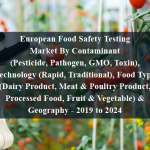OVERVIEW
Research by Global Market Studies has reported a CAGR of 6.8% for the Agricultural Sprayers Market, expecting to expand to a value of USD 6.8 billion by 2028.
The agricultural sprayers market refers to the industry involved in the manufacturing, distribution, and sale of equipment designed to apply various substances, such as pesticides, herbicides, fertilizers, and water, onto crops and plants for the purpose of enhancing growth, protecting against pests and diseases, and improving overall agricultural productivity. These sprayers are used in various agricultural practices, ranging from large-scale commercial farming to smaller-scale operations.
Agricultural sprayers control pests, herbicides, fertilizers, diseases, irrigation, crop nutrition, and specific applications. They use advanced technologies for precision agriculture, weed management, crop protection, and crop enhancement. They also contribute to food security and sustainability.
Table of Content
Market Dynamics
Drivers:
The growing global population demands higher agricultural productivity, leading to increased demand for efficient crop protection and nutrient application. Agricultural sprayers help optimize crop health, leading to increased productivity and profitability. They also aid in pest and disease management by providing targeted application of pesticides and fungicides.
Environmental concerns and regulatory pressures push for sustainable farming practices, requiring precision spraying to minimize chemical overuse. Technological advancements, such as GPS-guided precision sprayers, drones, and sensor-based application systems, enable more accurate and efficient resource use. Precision agriculture involves data-driven decision-making, with agricultural sprayers equipped with advanced technologies applying inputs where they are needed most.
Farm mechanization, such as self-propelled sprayers, becomes attractive as labor costs rise. Changing climate patterns demand flexible farming practices, with sprayers playing a role in mitigating weather-related challenges.
Opportunities:
The market offers a variety of sprayer types, including handheld, backpack, mounted, trailed, and self-propelled models, catering to different farm sizes and application needs. Precision spraying technology, capacity, and efficiency are available to optimize operational efficiency. Customization options are available based on specific farmer requirements.
User-friendly designs, intuitive controls, and ergonomic features make sprayers easier for operators to handle, reducing fatigue and improving productivity. Integration with farm management systems enables better decision-making and resource allocation based on real-time field data. Modern sprayers are designed to minimize chemical drift, reduce environmental impact, and comply with strict regulations. Advanced sprayers allow remote monitoring and control through mobile apps or online platforms, enhancing operational convenience.
Manufacturers often provide training and technical support for proper operation, maintenance, and troubleshooting of sprayers. Additionally, aerial spraying solutions, such as drones with spraying capabilities, enable quick coverage of large fields and challenging terrains.
Restraints:
Agricultural sprayers, particularly advanced technologies, can be expensive and require significant initial investment, limited awareness, and maintenance. In some regions, farmers may lack adequate training and access to proper usage. Complex sprayer systems also require regular repairs, which can increase costs and downtime. Regulatory challenges, such as pesticide application, environmental impact, and worker safety, can make it difficult for manufacturers and farmers to navigate compliance requirements.
Additionally, there may be a skill gap in operating advanced sprayers due to the technical expertise required. Environmental concerns include potential negative impacts on ecosystems and non-target organisms, as well as resistance and residue issues. Insufficient infrastructure, such as roads and storage facilities, can also hinder the distribution and use of agricultural sprayers in certain regions.
Regional Information:
North America:The United States and Canada have a highly mechanized agriculture sector, leading to substantial adoption of advanced sprayer technologies. Precision agriculture is prevalent, driven by large farms and the need for efficient resource utilization.
Europe: European countries have stringent regulations regarding chemical application and environmental protection. Precision farming practices are well-established, with a focus on reducing chemical usage and minimizing environmental impact.
Asia-Pacific: The Asia-Pacific region includes diverse markets. Countries like China and India have large agricultural sectors with a mix of traditional and modern farming practices. Increasing awareness of sustainable agriculture is driving the adoption of precision sprayers.
Recent Developments:
• In November 2022, DJI released the upgraded T50 with two sets of active phased array radars, two sets of binocular vision, and a dual atomization spraying system, which integrates functions of aerial survey and flight defense. Weighed at 52kg, it supports the spreading of a 50kg load and spraying a 40kg load, with a 2200mm maximum wheelbase, 16 L/min spraying and 108 kg/min sowing. It is also equipped with a seven-inch remote controller screen, which supports intelligent route planning and a transmission distance as far as 2 km.
• In November 2022, Pyka, maker of the Pelican Spray, a fully autonomous and 100% electric agricultural aerial application aircraft, received the first ever regulatory approval to fly unmanned aerial spray missions at night with a fixed wing aircraft. Authorized by the General Directorate of Civil Aviation (DGAC) in Costa Rica, the Pelican Spray has approval to be used by Pyka’s local customers to spray large commercial banana plantations, both day and night.
Key Players:
John Deere, CNH Industrial, Kubota, Mahindra, STIHL, AGCO, Yamaha, Bucher Industries, EXEL Industries, AMAZONEN-Werke, BGROUP, Agro Chem, Boston Crop Sprayers, H&H Farm Machine Co., Buhler Industries, AG Spray Equipment, DJI, Case IH, H.D. Hudson Manufacturing Co., and John Rhodes.
Frequently Asked Questions
1) What is the projected market value of the Agricultural Sprayers Market?
– The Agricultural Sprayers Market is expected to reach a value of USD 3.5 billion by 2028.
2) What is the estimated CAGR of the Agricultural Sprayers Market over the 2023 to 2028 forecast period?
– The Agricultural Sprayers Market is expected to grow at a CAGR of approximately 6.8% from 2023 to 2028.
3) Who are the key players in the Agricultural Sprayers Market?
– John Deere, CNH Industrial, Kubota, Mahindra, STIHL, AGCO, Yamaha, Bucher Industries, EXEL Industries, AMAZONEN-Werke, BGROUP, Agro Chem, Boston Crop Sprayers, H&H Farm Machine Co., Buhler Industries, AG Spray Equipment, DJI, Case IH, H.D. Hudson Manufacturing Co., and John Rhodes.
4) What are the drivers for the Agricultural Sprayers Market?
– Global population demands higher agricultural productivity, requiring efficient crop protection, nutrient application, and sustainable farming practices. Precision sprayers, GPS-guided systems, and mechanization enhance efficiency and adapt to changing climates.
5) What are the restraints and challenges in the Agricultural Sprayers Market?
– Advanced agricultural sprayers are expensive, require initial investment, limited awareness, maintenance, and training, with regulatory challenges, skill gaps, environmental concerns, and insufficient infrastructure hindering their use.
6) What are the key applications and offerings of the Agricultural Sprayers Market?
– Agricultural sprayers control pests, herbicides, fertilizers, diseases, irrigation, crop nutrition, and specific applications. They use advanced technologies for precision agriculture, weed management, crop protection, and crop enhancement.
7) Which region is expected to drive the market for the forecast period?
– Asia Pacific has the highest value share in the global market and is expected to dominate shares in forecast period.
Why Choose Us?
Insights into Market Trends: Global Market Studies reports provide valuable insights into market trends, including market size, segmentation, growth drivers, and market dynamics. This information helps clients make strategic decisions, such as product development, market positioning, and marketing strategies.
Competitor Analysis: Our reports provide detailed information about competitors, including their market share, product offerings, pricing, and competitive strategies. This data can be used to inform competitive strategies and to identify opportunities for growth and expansion.
Industry Forecasts: Our reports provide industry forecasts, which will inform your business strategies, such as investment decisions, production planning, and workforce planning. These forecasts can help you to prepare for future trends and to take advantage of growth opportunities.
Access to Industry Experts: Our solutions include contributions from industry experts, including analysts, consultants, and subject matter experts. This access to expert insights can be valuable for you to understand the market.
Time and Cost Savings: Our team at Global Market Studies can save you time and reduce the cost of conducting market research by providing comprehensive and up-to-date information in a single report, avoiding the need for additional market research efforts.












